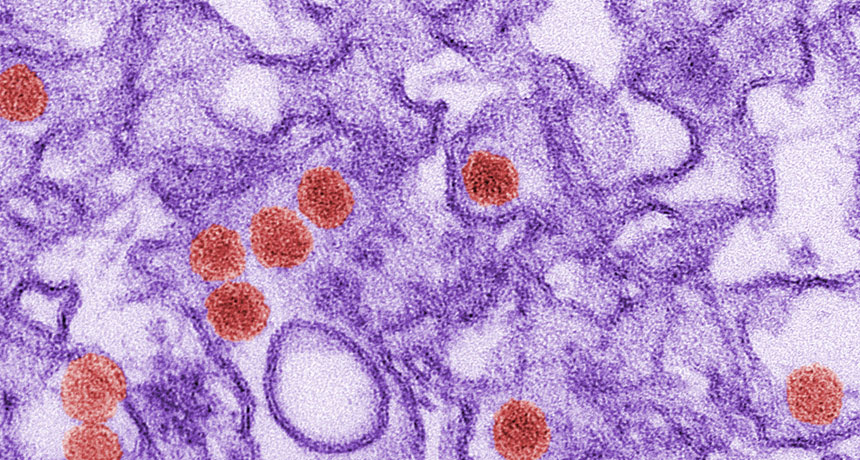Scientists link Zika to nerve disease
Increase in Guillain-Barré syndrome raises concern among health officials

This is an electron micrograph of the Zika virus. A new study strengthens the link between the virus and a devastating neurological condition.
CDC
By Laura Sanders and Meghan Rosen
Throughout the Americas, the rate of Zika infections has been exploding. For some adults, Zika virus is no more than a rashy, flulike nuisance. But in a handful of people, a new study finds, the virus may trigger a severe nerve disease. This rare condition is called Guillain-Barré syndrome.
It begins as the body’s immune system attacks peripheral nerves. These nerves form a system that connects the brain and spinal cord to the rest of the body. Guillain-Barré (Gee-YAHN bur-RAY) often causes weakness or tingling in the lower extremities (legs). In severe cases, total paralysis can result. Until they recover, the affected people may depend on a ventilator in a hospital’s intensive care unit in order to breathe.
Clearly, it’s a serious disease. Indeed, 3 to 5 percent of people with this nerve condition die from complications, scientists estimate.
The new study looked at a Zika outbreak that occurred in French Polynesia in 2013 and 2014. About one in every 4,000 people with Zika got Guillain-Barré syndrome, researchers now estimate.
During that outbreak, 42 people were diagnosed with Guillain-Barré. All had antibodies that also signaled a Zika infection. (Antibodies are proteins that the body’s immune system produces in response to an infection.) Most patients also had recent Zika symptoms. These people were compared to a control group — hospital patients who did not have Guillain-Barré. Researchers saw signs of Zika less frequently in them. Just 54 out of 98 patients who were tested showed signs of the virus. The new study appeared online February 29 in The Lancet.
Zika has recently hit several countries in the Americas quite hard. These countries “need to be prepared to have adequate intensive-care beds capacity to manage patients with Guillain-Barré syndrome,” the study’s authors write.
The study “tells us what I think a lot of people already thought: that Zika can cause Guillain-Barré syndrome,” says Ernesto Marques. He is a public-health researcher at the University of Pittsburgh in Pennsylvania. Guillain-Barré is one of two rare conditions that have been associated with Zika. The other is microcephaly (My-kro-SEF-uh-lee). Babies born with this condition have abnormally small heads. But with both conditions, more work needs to be done to prove they are caused by Zika.
(Story continues below image)

Several countries where Zika is now spreading also have reported upticks in Guillain-Barré syndrome. Colombia, for instance, usually sees about 220 cases of this syndrome each year. But doctors diagnosed 86 cases in just five weeks — between mid-December 2015 and late January 2016. That’s according to the World Health Organization (WHO) in Geneva, Switzerland. Other Zika-affected countries have also reported unusually high numbers of Guillain-Barré. These include Brazil, El Salvador and Venezuela.
The link between Zika and Guillain-Barré seems strong. Still, Marques stresses that the risk of getting the syndrome after a Zika infection remains quite low. “It’s important that people don’t think that if you get Zika, you are going to get Guillain-Barré.” The chance of getting it is much less than 1 percent, he says.
And it’s too early to say whether the rate of Guillain-Barré estimated in the paper will be the same in ongoing Zika outbreaks, notes Anna Durbin. She is a vaccine expert at Johns Hopkins University in Baltimore, Md. “We have a number now, but it’s not perfect,” she says. Ongoing studies in Brazil and other countries affected by Zika will help refine the rate.
Other viruses also can trigger Guillain-Barré. These include HIV, influenza and dengue. It’s possible this occurs through their interactions with the body’s immune system. For now, details remain mysterious.
The timing of Guillain-Barré’s onset may just make it easier for scientists to pin it on Zika than to link this virus to microcephaly. The syndrome shows up days or weeks after an infection subsides. By contrast, it takes months to see what happens with babies born to infected mothers, noted Bruce Aylward, with WHO. He spoke during a news briefing on February 19.
Scientists are now conducting a many-nation study on Guillain-Barré. They may soon expand it into Brazil and Colombia. There, they may look for signs linking Zika infection to the syndrome, says Bart Jacobs. He is an immunologist at Erasmus University Medical Center in Rotterdam, the Netherlands. Jacobs is helping supervise this study. Other studies also might help explain why some people are susceptible to Guillain-Barré. Genetics, previous viral infections or toxins may all play a role.
Power Words
(for more about Power Words, click here)
antibody Any of a large number of proteins that the body produces as part of its immune response. Antibodies neutralize, tag or destroy viruses, bacteria and other foreign substances in the blood.
control A part of an experiment where there is no change from normal conditions. The control is essential to scientific experiments. It shows that any new effect is likely due only to the part of the test that a researcher has altered. For example, if scientists were testing different types of fertilizer in a garden, they would want one section of it to remain unfertilized, as the control. Its area would show how plants in this garden grow under normal conditions. And that give scientists something against which they can compare their experimental data.
dengue fever A potentially lethal infectious disease transmitted by mosquitoes. No vaccine yet exists to prevent infection with the virus responsible for the disease, which causes high fevers, severe headache, joint pain, pain behind the eyes, rash, bone pain and sometimes mild bleeding. A more severe form of the disease, known as dengue hemorrhagic fever can cause uncontrolled bleeding if not treated right away.
French Polynesia A nation consisting of more than 100 islands in the South Pacific.
genetic Having to do with chromosomes, DNA and the genes contained within DNA. The field of science dealing with these biological instructions is known as genetics. People who work in this field are geneticists.
Guillain-Barré syndrome Pronounced Gee-YAHN Bur-RAY. A rare condition that begins as the body’s immune system attacks peripheral nerves, causing weakness or tingling in the lower extremities. In severe cases, total paralysis can result. Three to 5 percent of people with Guillain-Barré die from complications, scientists estimate. The syndrome is thought to be a complication of several infectious diseases, including HIV, dengue, influenza and Zika.
HIV (short for Human Immunodeficiency Virus) A potentially deadly virus that attacks cells in the body’s immune system and causes acquired immune deficiency syndrome, or AIDS.
immune system The collection of cells and their responses that help the body fight off infections and deal with foreign substances that may provoke allergies.
immunology The field of biomedicine that deals with the immune system. A doctor or scientist who works in that field is known as an immunologist.
infection A disease that can spread from one organism to another.
influenza (or flu) A highly contagious viral infection of the respiratory passages causing fever and severe aching. It often occurs as an epidemic.
microcephaly A birth defect in which a baby is born with a head that is smaller than expected. Other problems may also develop, including seizures, developmental delays, hearing and vision problems, and problems with movement and balance.
nerves Long, delicate fibers that communicate across the body of an animal. An animal’s backbone contains many nerves, some of which control the movement of its legs or fins, and some of which convey sensations such as hot, cold, pain.
neurological disease A disease of the brain, spinal cord or nerves.
outbreak The sudden emergence of disease in a population of people or animals. The term may also be applied to the sudden emergence of devastating natural phenomena, such as earthquakes or tornadoes.
paralysis The inability to willfully move muscles in one or more parts of the body. In some cases, nerves that carry the signal to move may have been severed or damaged. In other cases, the brain may be the source of the problem: It may fail to understand or act on a nerve’s signal to move.
proteins Compounds made from one or more long chains of amino acids. Proteins are an essential part of all living organisms. They form the basis of living cells, muscle and tissues; they also do the work inside of cells. The hemoglobin in blood and the antibodies that attempt to fight infections are among the better-known, stand-alone proteins.Medicines frequently work by latching onto proteins.
toxin A poison produced by living organisms, such as germs, bees, spiders, poison ivy and snakes.
vaccine A biological mixture that resembles a disease-causing agent. It is given to help the body create immunity to a particular disease. The injections used to administer most vaccines are known as vaccinations.
ventilator (in medicine) A device used to help a person breathe — take in oxygen and exhale carbon dioxide — when the body cannot easily do that on its own.
virus Tiny infectious particles consisting of RNA or DNA surrounded by protein. Viruses can reproduce only by injecting their genetic material into the cells of living creatures. Although scientists frequently refer to viruses as live or dead, in fact no virus is truly alive. It doesn’t eat like animals do, or make its own food the way plants do. It must hijack the cellular machinery of a living cell in order to survive.
Zika virus A virus that can be transmitted to humans via mosquitoes. About 20 percent of infected people get sick. Symptoms include a slight fever, rash and pinkeye and usually fade quickly. A growing body of evidence suggests that the virus could also cause a devastating birth defect — microcephaly. Evidence suggests it may also cause neurological conditions such as Guillain-Barré syndrome.







